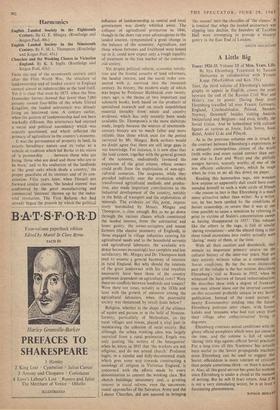Harmonics
English Landed . Society in the Eighteenth
FROM the end of the seventeenth century until after the First - World War, the structure of landownership and of landed society in England seemed almost as indestructible as the land itself. Yet it is clear that even by 1873, when the New Domesday Survey showed that fewer than 7,000 persons owned four-fifths of the whole United Kingdom, the landed aristocracy was already living on borrowed time. A century earlier, when the pattern of landownership had not been markedly different, this aristocracy had enjoyed a social and political ascendancy which was scarcely questioned, and which reflected the primacy of agriculture in the country's economy.
It was, the permanence of property in land, its strictly hereditary nature and its value as a vehicle of tradition which led Burke to his vision of 'a partnership . . . between those who are living, those who are dead and those who are to be born,' and to his exaltation of the landlords as 'the great oaks which shade a country,' the proper guardians of its interests and of its con- stitution. Fifty years later, when Disraeli put forward similar claims, 'the landed interest' was confronted by the great manufacturing and commercial 'interests' thrown up by the indus- trial revolution.. The First Reform Act had already begun the process by which the political
influence of landownership in central and local government was slowly whittled away. The collapse of agricultural protection -in 1846, though in the short run even advantageous to the landed interest, symptomised a great change in the balance of the economy. Agriculture, and those whose fortunes and livelihood were bound up in it, could now expect only a rough equality of, treatment in the free market of the commer- cial society.
Yet despite political reform, economic revolu- tion and the frontal assaults of land reformers, the landed interest, and the social order con- nected with it, survived into the twentieth century. Its history, the modern study of which was begun by Professor Habbakuk over twenty years ago; is the theme of two important and scholarly books, both based on the products of specialised research and on much unpublished material (notably from estate and country archives), which has only recently been made available. Dr. Thompson's is the more elaborate study, largely because the sources of nineteenth- century history are so much fuller and more reliable than those which exist for the period surveyed by Mr. Mingay. Both authors would no doubt agree that there are still large gaps in our knowledge. For instance, it is now clear that the land system, together with the general growth of the economy, undoubtedly favoured the expansion of the great estates, whose owners could profit from the exploitation of non-agri- cultural resources. The magnates, while they presided indirectly over the revolution which transformed agricultural methods and produc- tion, also made important contributions to the industrial development of the country, notably in the fields of transport and the exploitation of minerals. The evideice on this point, impres- sively marshalled by Messrs. Mingay and Thompson, is' clear enough. But as we go down through- the various classes which constituted the landed interest, from the substantial and lesser gentry, the owner-occupiers and tenant farmers (the elusive yeomanry of England), to those engaged in village industries catering for agricultural needs and to the household servants and agricultural labourers, the available evi- dence becomes increasingly less complete and less satisfactory. Mr. Mingay and Dr. Thompson both tend to assume a general harmony of interests in rural England. But why should the interests of the great landowner with his coal royalties necessarily have been those of the country gentleman dependent on agricultural rents? Were there no conflicts between landlords and tenants? Were there not times, notably in the 1830s and later with the growth of unionism among the agricultural labourers, when the paternalist society was threatened by revolt from below?
Religion, whether in the shape of the alliance of squire and parson or in the hold of Noncon- formity, particularly of Methodism, on the rural villages and towns, played a vital 'Part in maintaining the cohesion of rural society. But although the urban working class was largely recruited from a rural proletariat, Engels was only quoting 'the writers of the bourgeoisie' - when he wrote in 1845 that 'the workers are not religious, and do not attend church.' Professor Inglis, in a careful and fully-documented study which goes some way towards constructing a sociology of religion in Victorian England, is concerned with the efforts made by every denomination to convert the working class. But church buildings; missionary zeal, a growing interest in social reform, even the unconven- tional approaches of-the Salvation Army and the Labour Churches, did not succeed in bringing
`the masses' into the churches of 'the classes.' It is ironical that when the landed aristocracy was slipping into decline, the founders of 'Toynbee Hall were attempting to provide a resident gentry in the East End of London.
ANGUS maciNtyag






























 Previous page
Previous page